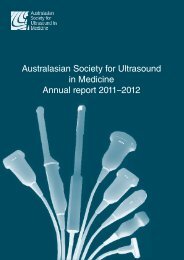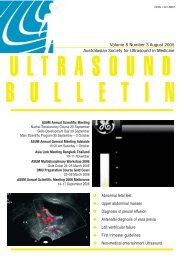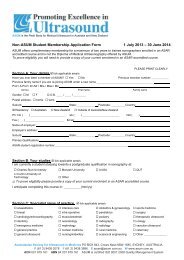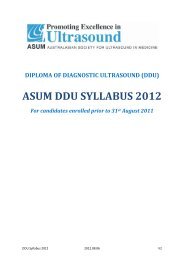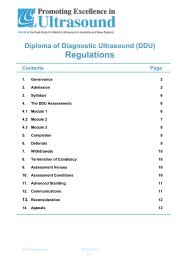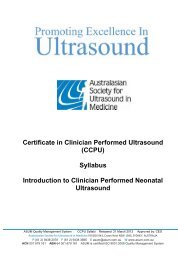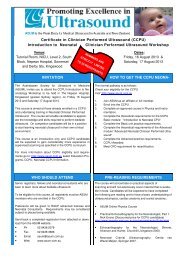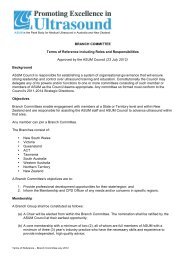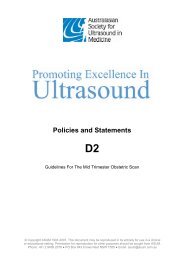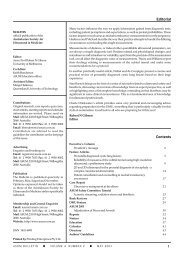DDU(Vascular) - Australasian Society for Ultrasound in Medicine
DDU(Vascular) - Australasian Society for Ultrasound in Medicine
DDU(Vascular) - Australasian Society for Ultrasound in Medicine
- No tags were found...
Create successful ePaper yourself
Turn your PDF publications into a flip-book with our unique Google optimized e-Paper software.
<strong>DDU</strong>(<strong>Vascular</strong>) SyllabusPart B: Pr<strong>in</strong>ciples of Image/Data Collection andOptimisation(15% Weight<strong>in</strong>g)RATIONALEThe aim of any ultrasound exam<strong>in</strong>ation is to produce accurate, valid and cl<strong>in</strong>ically useful<strong>in</strong><strong>for</strong>mation. In achiev<strong>in</strong>g this aim all professionals <strong>in</strong>volved <strong>in</strong> the ultrasound exam<strong>in</strong>ationmust have adequate underp<strong>in</strong>n<strong>in</strong>g knowledge and skill <strong>in</strong>: ultrasound physics and<strong>in</strong>strumentation (Part A of this syllabus); the major techniques used, pr<strong>in</strong>ciples appliedand potential pitfalls encountered <strong>in</strong> produc<strong>in</strong>g an exam<strong>in</strong>ation; the standard term<strong>in</strong>ologyand pr<strong>in</strong>ciples of report<strong>in</strong>g <strong>in</strong><strong>for</strong>mation used to describe ultrasound appearances and thecare and ma<strong>in</strong>tenance of the equipment to ensure safe and accurate use.AIMFor the candidate to demonstrate knowledge and application of the pr<strong>in</strong>ciplesunderp<strong>in</strong>n<strong>in</strong>g the production of an accurate and valid ultrasound exam<strong>in</strong>ation that can beused as foundational knowledge <strong>for</strong> ongo<strong>in</strong>g practice <strong>in</strong> the field of diagnostic ultrasound.LEARNING OBJECTIVES1. Describe a range of techniques that can be used to ensure the best qualityexam<strong>in</strong>ation is obta<strong>in</strong>ed <strong>in</strong>clud<strong>in</strong>g: patient position<strong>in</strong>g and breath<strong>in</strong>g; thoroughsystematic scann<strong>in</strong>g throughout relevant organs/structures.2. Describe and be able to apply a range of probe manipulation techniques <strong>in</strong> orderto produce an accurate, valid and efficient exam<strong>in</strong>ation.3. Def<strong>in</strong>e and be able to recognise standard scan planes, image orientation andassociated term<strong>in</strong>ology used <strong>in</strong> general ultrasound applications and recognisewhere there may be variations used <strong>in</strong> particular fields (eg <strong>in</strong>tracavity scann<strong>in</strong>gand cardiac ultrasound).4. Describe the pr<strong>in</strong>ciples of adequate documentation of ultrasound images and data<strong>in</strong>clud<strong>in</strong>g labell<strong>in</strong>g of images/data, and record<strong>in</strong>g and archiv<strong>in</strong>g methods.5. Def<strong>in</strong>e and be able to accurately apply standard term<strong>in</strong>ology used to describeultrasound appearances.6. Describe the use of, and be able to apply, equipment controls to optimise thequality of the images/data produced <strong>in</strong>clud<strong>in</strong>g: time ga<strong>in</strong> compensation (TGC);power/”ga<strong>in</strong>”; focus; depth and zoom; pr<strong>in</strong>ciples of measurement to enhanceaccuracy.7. Describe the general pr<strong>in</strong>ciples of ultrasound guidance <strong>for</strong> <strong>in</strong>terventionalprocedures.8. Describe general pr<strong>in</strong>ciples of care and ma<strong>in</strong>tenance of equipment.9. Describe and be able to apply pr<strong>in</strong>ciples of <strong>in</strong>fection control <strong>in</strong> the use ofultrasound and its associated equipment.11




